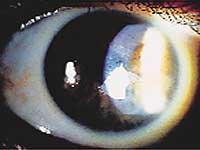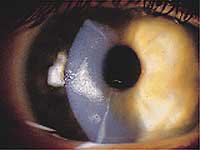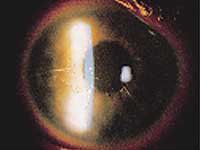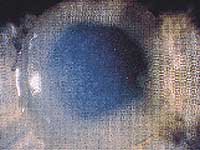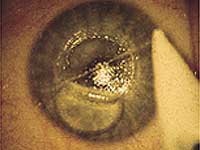Innovative management cascade treats epithelial ingrowth in LASIK
Prevention of epithelial ingrowth is the most effective regimen.
Epithelial ingrowth is a noted complication of laser in situ keratomileusis (LASIK) that involves downgrowth of epithelial cells from the surface of the cornea into the interface.
Epithelial ingrowth can present itself in various forms. More generally, it can be broken down into peripheral and central forms. From the management point of view, it is important to decide when epithelial ingrowth is clinically significant, and if so, is it visually or mechanically significant.
Visual significance can occur in two ways. Direct involvement affects the visual axis, while indirect involvement affects the visual axis by causing adjacent astigmatism or a corneal melt that leads to visual axis distortion.
Visual significance also can be graded as stationary or progressive. Progressive cases can be graded by density on a scale of 1 to 3. Grade 1 cases involve minimal haze with good visualization of the anterior chamber and iris. Grade 3 cases involve an inability to visualize the anterior chamber and iris underneath the epithelium.
Mechanically significant ingrowth can lead to corneal melting or scarring that leads to or threatens corneal integrity.
To summarize, epithelial ingrowth requires three factors to present itself:
1. Source of surface epithelium
2. Surface deficit: that is, abrasion, ulcer, epithelial defect, edge fistula.
3. Space to grow into, such as the lamellar flap or pre-existing incisions in the cornea from radial keratotomy or other procedures, which allow epithelial cells to track along their path of least resistance.
It consists of two kinds of tissue, epithelium and scariform tissue. It involves four surfaces, the underside of the corneal flap, the flap edge, the stromal bed and the flap hinge.
Effects caused can be divided into (1) direct or indirect visual, (2) tectonic and (3) aesthetic. Management is undertaken for the first two types of effects only. The Management Cascade (see illustration) outlines a simplified protocol to follow and effectively manage this complication.
Management
Presentation can be in the form of decreased vision caused by direct or indirect effects of the epithelial ingrowth, the management of which will depend on whether the ingrowth is diffuse (involving the entire interface) or focal.
If the focal ingrowth is in the center of the LASIK bed, management can be accomplished with a YAG laser. This may require more than one sitting.
Focal peripheral ingrowth can be treated with surface cryotherapy. The cryo-pen is applied to the flap surface until a total whitening of the ingrown epithelium occurs. The treated epithelial ingrowth can then be milked out through incisions from previous refractive surgeries, through a cut-down incision or by partially lifting the flap with a pocket dissection.
Diffuse epithelial ingrowth can present as a nonadherent corneal flap, as an excessively swollen corneal flap and as obvious epithelial ingrowth in the interface. Management of this condition involves lifting the corneal flap and removing the ingrown tissue from the four surfaces previously mentioned.
Task-specific instruments such as the Gulani LASIK Revision Set (Bausch & Lomb Surgical) can be used to address this situation for a flap lift.
Some doctors advocate using chemicals such as alcohol and antimetabolites. Excimer laser smoothing can also be done in recalcitrant cases. In most of the cases, the flap falls back into place and adheres well enough to the stromal bed.
In cases of inadequate adherence, surgeons can use stitches to lay the flap down and back into place. The stitches can be taken off in 3 days to avoid any refractive effect.
Prevention
The incidence of epithelial ingrowth is decreasing because of increased awareness, minimal flap handling and better instrumentation. The incidence is now in the range of 1% to 2% in worldwide studies and less than 1% in most centers in the United States.
Once epithelial ingrowth occurs, it is difficult to eradicate. Because prevention in the best management, surgeons must be aware of predisposing factors such as unstable epithelium (corneal dystrophies), epithelial defects, dry eye or previous incisional surgery. If any component of dry eye exists, surgeons can implant dissolvable collagen plugs.
Also, surgeons can apply minimal flap handling and minimal fluidics by using specially designed instruments, such as the Gulani LASIK cannula.
Comanaging optometrists should be alerted to this occurrence. Constant vigilance, early detection and heightened suspicion in predisposed cases is a must for safe and effective LASIK surgery.
|
|
|
|
|
|
|
|
|
For Your Information:References:
- Arun C. Gulani, MD, can be reached at 119 Kings St., Hicksville, NY 11801; (516) 993-0990; fax: (516) 937-0538; e-mail: arungulani@aol.com. Ocular Surgery News could not confirm whether or not Dr. Gulani has a direct financial interest in any of the products mentioned in this article or if he is a paid consultant for any companies mentioned.
Gulani AC. LASIK complications: A new stratified classification. Ophthalmology 1999;106:1457-1458.
- Gulani AC. New instrument for revision lamellar refractive surgery. Jrnl Cat Ref Surg 1998;24:595.

